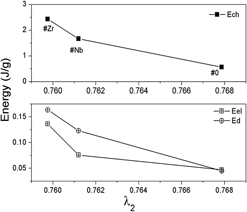Crossref Citations
This article has been cited by the following publications. This list is generated based on data provided by
Crossref.
Han, X. L.
Song, K. K.
Zhang, L. M.
Xing, H.
Sarac, B.
Spieckermann, F.
Maity, T.
Mühlbacher, M.
Wang, L.
Kaban, I.
and
Eckert, J.
2018.
Microstructures, Martensitic Transformation, and Mechanical Behavior of Rapidly Solidified Ti-Ni-Hf and Ti-Ni-Si Shape Memory Alloys.
Journal of Materials Engineering and Performance,
Vol. 27,
Issue. 3,
p.
1005.
Canbay, Canan Aksu
Karaduman, Oktay
Ünlü, Nihan
and
Özkul, İskender
2020.
An exploratory research of calorimetric and structural shape memory effect characteristics of Cu–Al–Sn alloy.
Physica B: Condensed Matter,
Vol. 580,
Issue. ,
p.
411932.
Abdelghafar, K.A.
Hussein, A.A.
Elbanna, E.M.
Waly, M.A.
and
Ibrahim, M.M.
2021.
Influence of thermo-mechanical treatment on mechanical properties and shape memory effect of CuAlNiMnTi shape memory alloys.
Intermetallics,
Vol. 136,
Issue. ,
p.
107251.
Zarinejad, Mehrdad
Wada, Kiyohide
Pahlevani, Farshid
Katal, Reza
and
Rimaz, Sajjad
2021.
Martensite and reverse transformation temperatures of TiAu-based and TiIr-based intermetallics.
Journal of Alloys and Compounds,
Vol. 870,
Issue. ,
p.
159399.
Canbay, Canan Aksu
Karaduman, Oktay
Ünlü, Nihan
Özkul, İskender
and
Çiçek, Mehmet Ali
2021.
Energetic Behavior Study in Phase Transformations of High Temperature Cu–Al–X (X: Mn, Te, Sn, Hf) Shape Memory Alloys.
Transactions of the Indian Institute of Metals,
Vol. 74,
Issue. 10,
p.
2447.
Wolf, Witor
and
Mazzer, Eric M.
2022.
The influence of particle size and heat treatments on the transformation energies of a gas atomized Cu-Al-Ni-Mn shape memory alloy.
Thermochimica Acta,
Vol. 707,
Issue. ,
p.
179107.
Mazzer, E. M.
da Silva, M. R.
and
Gargarella, P.
2022.
Revisiting Cu-based shape memory alloys: Recent developments and new perspectives.
Journal of Materials Research,
Vol. 37,
Issue. 1,
p.
162.
Gomes, Edelize Angélica
Mazzer, Eric Marchezini
and
Lins, Vanessa de Freitas Cunha
2023.
Electrochemical behavior of a spray formed Cu-Al-Ni-Mn shape memory alloy.
Materials Today Communications,
Vol. 35,
Issue. ,
p.
105570.
Vedamanickam, Sampath
Vageeswaran, Poojalakshmi
and
Jacob, Bharathy
2023.
Theoretical analysis and design of Ti-based shape memory alloys correlating composition and electronic properties to transformation temperatures for high temperature applications.
Materials Science and Engineering: B,
Vol. 296,
Issue. ,
p.
116681.
Raji, Hatim
Rad, Milad
Acar, Emre
Karaca, Haluk
and
Saedi, Soheil
2024.
A machine learning approach to predict austenite finish temperature in quaternary NiTiHfPd SMAs.
Materials Today Communications,
Vol. 38,
Issue. ,
p.
107847.
Saedi, Soheil
and
Raji, Hatim
2024.
Next-generation multicomponent SMAs: leveraging HEA empirical parameters.
Scripta Materialia,
Vol. 252,
Issue. ,
p.
116262.
Tan, Changlong
Zhang, Mingchao
Yang, Jie
Wang, Xiaochuan
Zhao, Wenbin
Li, Jian
Zhao, Quanliang
and
Tian, Xiaohua
2025.
Ultra-high performance Cu-Al-Ni as phase change material for thermal management of high-power electronic devices.
Journal of Energy Storage,
Vol. 113,
Issue. ,
p.
115635.
Kim, Jeongsoo
Kim, Yongjoo
Kim, Wontae
Park, Eunsoo
and
Kim, Dohyang
2025.
Microstructure and transformation temperatures of Si-added Ni–Ti–Cu and Ni–Ti–Zr shape memory alloys.
Journal of Materials Science,
Vol. 60,
Issue. 3,
p.
1535.




